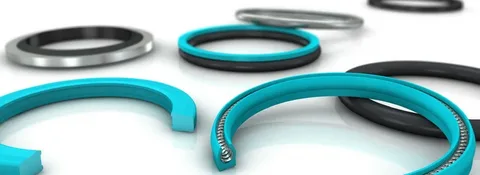Sealing components are vital to rotating and reciprocating equipment’s performance, safety, and efficiency. Industrial seal rings prevent leakage, protect internal parts, and ensure smooth operation in systems like turbines, compressors, and pumps. These small components play a big role in industries from energy to aerospace. This article covers their functions, types, materials, and key applications, highlighting why they’re essential to reliable industrial operations.
What Are Industrial Seal Rings?
Industrial seal rings are precision components that prevent fluid or gas leaks between rotating and stationary parts in machinery. Installed around shafts or within housings, they maintain pressure, block contaminants, and reduce friction, which ensures smooth, efficient operation.
Used in turbines, compressors, pumps, piston systems, and high-pressure joints, these rings must be durable, precise, and capable of withstanding extreme heat, pressure, and chemical exposure. Their performance directly impacts equipment longevity, safety, and overall efficiency.
Common Types of Industrial Seal Rings
Seal rings come in a variety of forms, each designed to meet specific operating conditions:
1. Carbon Graphite Seal Rings
Carbon graphite seal rings are used in high-speed, high-temperature environments. They offer excellent wear resistance, self-lubrication, and chemical compatibility, making them ideal for compressors, turbines, and pumps.
2. Metal Seal Rings
Metal seal rings, made from stainless steel, Inconel, or other alloys, are suitable for extreme pressure applications. They can be spring-loaded or interference-fitted.
3. PTFE Seal Rings
Known for low friction and chemical resistance, PTFE (Teflon®) seal rings are used in applications where temperature and pressure are moderate but chemical resistance is crucial.
4. Elastomeric Seal Rings
Elastomeric seals, such as O-rings and V-rings, are common in hydraulic and pneumatic systems. They offer flexibility and good sealing properties for dynamic applications.
5. Segmented Seal Rings
Segmented rings, made from multiple arc-shaped pieces, are used when full-ring installation isn’t possible. They are often found in turbines or large compressors.
Materials Used in Industrial Seal Rings
Seal ring performance depends heavily on material selection. Common materials include:
● Carbon graphite: Excellent for dry-running applications and high-speed equipment
● Resin-impregnated carbon: Adds strength and reduces porosity
● PTFE (polytetrafluoroethylene): Great chemical resistance and low friction
● Silicon carbide or ceramic: Extremely hard, ideal for wear resistance
● Metals (steel, bronze, Inconel): Durable under pressure and temperature extremes
● Elastomers (NBR, Viton, EPDM): Flexible and cost-effective for general sealing
Material selection depends on operating temperature, pressure, speed, and the chemical nature of the fluid or gas being sealed.
Applications of Industrial Seal Rings
1. Power Generation
Steam and gas turbines rely on seal rings to contain pressure and prevent gas leakage. Materials like carbon, graphite, and metal alloys ensure long-term performance in high-heat conditions.
2. Oil and Gas
Compressors and pumps in exploration and refining operations require seal rings that can handle aggressive hydrocarbons and variable operating conditions.
3. Chemical Processing
Seal rings protect pumps and mixers from corrosive chemicals and high pressures, ensuring safety and efficiency.
4. Aerospace
Aircraft engines and fuel systems rely on lightweight, high-temperature seal rings to maintain performance at altitude and under extreme thermal cycling.
5. Food and Pharmaceutical
Hygienic systems use non-reactive PTFE and elastomeric seals that are easy to sanitize, ensuring clean operation without contamination.
Design Considerations for Industrial Seal Rings
When selecting or designing a seal ring for a specific application, engineers must evaluate several factors:
● Operating temperature and pressure
● Type of media (gas, liquid, corrosive substances)
● Shaft speed and alignment
● Sealing environment (vacuum, submerged, atmospheric)
● Installation accessibility and maintenance frequency
A well-designed seal ring will not only fit precisely but will also maintain consistent performance across fluctuating conditions.
Choose the Right Seal Rings
Industrial seal rings may be small, but they are outsized in machinery performance, safety, and efficiency. From controlling leaks to reducing wear and tear, these rings ensure that rotating and reciprocating equipment operates smoothly under demanding conditions.
With the right material, design, and maintenance approach, industrial seal rings can dramatically extend equipment life, reduce operating costs, and improve system reliability across various industries.

